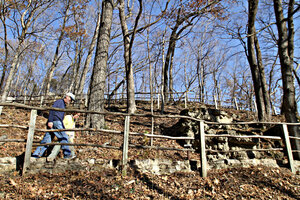Report: Decades of cover-up followed Iowa theft of native American remains
For years, National Park Service staff did little to uncover a former superintendent's theft of dozens of native American remains, according to an AP investigation.

Pedestrians hike one of the trails at Effigy Mounds National Monument in Harpers Ferry, Iowa in 2010. A 1990 theft of historically significant native American remains by a national monument superintendent entrusted with protecting them was larger and more harmful than previously acknowledged, the Associated Press reports.
ustin Hayworth/The Des Moines Register/AP
On Friday, a former National Park Service superintendent will be sentenced for the 1990 theft of dozens of native American remains originally entrusted to his watch. Responsibility for the ensuing cover-up goes beyond a single staff member, according to an investigation from the Associated Press.
Thomas Munson, the former superintendent of Effigy Mounds National Monument in Iowa, hid the remains of 40 native Americans who died between 700 and 2,500 years ago in damaging conditions in his garage for two decades. Yet subsequent superintendents did little to recover the remains, or notify local tribes about the theft.
"There will eventually come a day when this story likely sees the light of day," current superintendent Jim Nepstad wrote in a memo, "and at that time the National Park Service will be confronted with the difficult task of defending itself against the shameful actions of some of its employees."
In 1990, Mr. Munson learned of a new law about to go into effect, which would compel museums to return human remains to native American tribes, along with any sacred objects with which they had been buried. Anxious to keep the museum's collection of burial relics, he decided to secret away the museum's human remains.
Munson asked subordinate Sharon Greener to help him pack the museum’s collection of skeletal fragments into two boxes and transport them to Munson’s garage, where they sat for decades.
Although subsequent park administrators were aware of the disappearance after Munson’s 1994 retirement, they did little to recover the bones, documents uncovered by AP show. In 1998, an investigation by an outside contractor failed to resolve the mystery.
For years, Munson lied about the fate of the bones, saying that they might have been accidentally thrown away or taken to an archeological center.
Only after a 2011 investigation did Munson finally return one box of bones. In 2012, another investigation uncovered a second box of bones in Munson’s garage. Both boxes had suffered from improper storage.
In 2012, a National Park Service manager told an investigator that the theft was an example of NPS's "incompetence" as an agency, particularly the decision not to tell the 12 tribes affiliated with the monument that the skeletal remains had been taken, until the tribes discovered the theft themselves through the 2011 investigation.
"The offense of improperly removing the remains of more than 40 people is serious enough," wrote Mr. Nepstad in a memo, "but the consequences of covering up the offense and protecting the primary offender has made a very bad situation far worse."
Critics of the National Park Service's response to the theft say that the 12 tribes associated with the bones should have been told.
"These are people," said John Doershuk, Iowa’s state archeologist, in a National Park Service Press release, "and there are living peoples who care deeply about these remains, just as most modern Americans would about their ancestors."
Native American tribes have taken exception to treatment of their sacred religious and cultural artifacts several times in recent years. Just this May, several native American tribal leaders called for a Paris auction house to cease auctioning native American objects.
Munson pleaded guilty on charges of embezzling earlier this year. He will spend one year in home detention, ten weekends in jail, and pay $108,000 in restitution.
This report contains material from the Associated Press.

